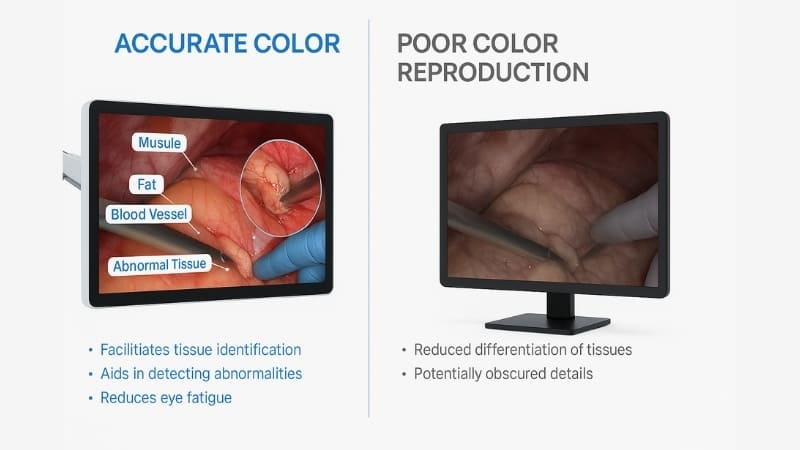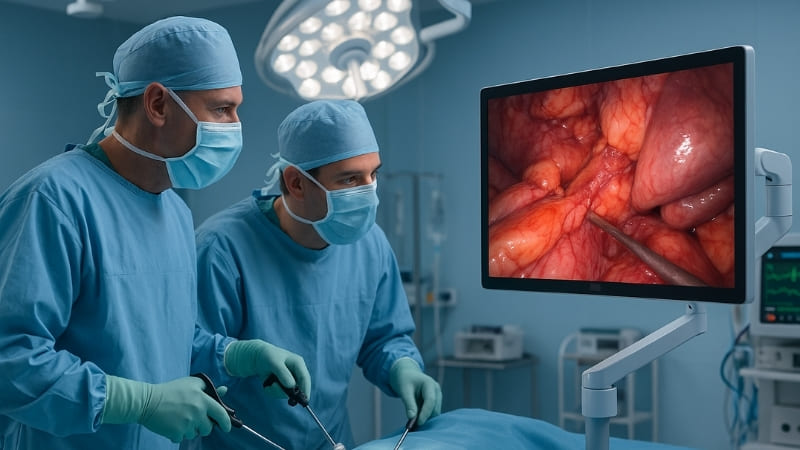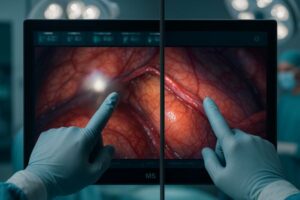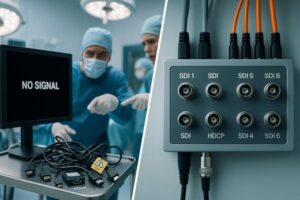Surgical displays aren’t your average monitors. They are precision instruments that provide surgeons with crystal-clear images during critical procedures.
A surgical display is a specialized medical monitor designed to provide surgeons with high-resolution, accurate, and reliable images during surgical procedures. They are crucial for visualizing anatomical details and guiding surgical instruments with precision.

How Does a Surgical Display Differ from a Regular Medical Monitor?
I always thought any monitor would do in an operating room. But surgical displays are a whole different beast, built for life-or-death situations.
Surgical displays are designed for the specific demands of the operating room. They offer higher resolution, better color accuracy, wider viewing angles, and specialized features like backlight stabilization and anti-glare coatings compared to regular medical monitors.

-
Image Quality: Regular monitors are fine for presentations, but surgeons need to see every tiny detail. Surgical displays are like super-HD magnifying glasses, ensuring accurate colors and stable brightness to prevent misjudgments.
-
Reliability: A good surgical display can cost a lot, but imagine if a blurry or delayed screen caused a surgeon to make a mistake. That cost is much higher than the equipment. It’s an investment in saving lives!
-
Durability: Hospital monitors at the reception desk are medical displays, but surgical displays need to withstand disinfectants, work stably for long hours, and support 4K/3D images. Regular screens fade over time, but there’s no room for compromise in the operating room.
-
Minimally Invasive Surgery: In many modern surgeries, doctors use cameras and instruments inside the body. The display is their "eye," and any blur or delay doubles the risk.
What Are the Key Features of a High-Quality Surgical Display? Essential for Precision
It’s not just about a bright screen. Surgical displays need to have a suite of features that help surgeons perform at their best.
Key features of a high-quality surgical display include high resolution (4K or higher), accurate color reproduction (wide color gamut), fast response time (low latency), high brightness and contrast ratio, backlight stabilization, and compliance with medical safety standards.

- High Resolution: Crucial to visualise fine details, particularly during intricate procedures
- Color Accuracy: Accurate colour reproduction enables surgeons to distinguish subtle tissue differences.
- Low Latency: Critical to reduce disorientiation and ensure precision.
- High Brightness: High brightness is important to be able to see the display clearly.
- Contrast Ratio: Provides great image clarity, thus allowing surgeons to accurately distinguish subtle anatomical structures.
Why is Color Accuracy Critical in Surgical Displays? A Matter of Life and Death
I never thought about color being so important in surgery. But when you’re dealing with human tissue, subtle color differences can be critical.
Color accuracy is critical in surgical displays because it allows surgeons to differentiate between various tissues and structures based on their subtle color variations. Accurate color reproduction helps surgeons identify abnormalities, assess tissue perfusion, and make informed decisions during surgery.

- Tissue Differentiation: Accurate color enables doctors to discern slight variations in tissue color, essential for pinpointing abnormalities.
- Precise Navigation: Consistent color representation assists surgeons in precisely navigating complex anatomical structures.
- Reduced Misinterpretation: Reliable color minimizes the risk of misinterpreting visual data, enhancing diagnostic accuracy.
- Enhanced Depth Perception: Exact color depth contributes to a more realistic three-dimensional perception, aiding in surgical precision.
- Improved Visualization: Optimized color settings, like the blue colour enhancement on the Reshin Medical surgical display, enhance the visibility of crucial details and reduce eye strain during operations.
How Are Surgical Displays Used in Minimally Invasive Procedures? The Surgeon’s "Eyes"
I’ve learned that surgical displays are especially important in minimally invasive surgery, where surgeons rely on cameras and monitors to guide their actions.
Surgical displays are essential in minimally invasive procedures because they provide surgeons with a magnified view of the surgical site through endoscopic cameras. High-quality surgical displays with low latency and accurate color reproduction enable surgeons to perform precise maneuvers and minimize tissue damage.

- Enhanced Visualization: During minimally invasive procedures, the display acts as the surgeon’s primary visual guide, offering a magnified view of the surgical area.
- Instrument Guidance: The high-quality display enables the surgeon to accurately guide surgical instruments, reducing the risk of unintended damage.
- Real-Time Feedback: Minimal latency is critical in providing real-time feedback to the surgeon, which enhances precision and coordination.
- Reduced Incisions: Utilizing surgical displays helps minimize incision sizes, leading to faster patient recovery times and reduced post-operative complications.
- Improved Outcomes: Better surgical display technology leads to overall improvements in surgical outcomes by enhancing the surgeon’s visualization and control.
Conclusion
Surgical displays are more than just screens; they are vital tools that enable surgeons to perform complex procedures with precision and accuracy. By understanding the key features and benefits of surgical displays, we can appreciate their role in modern healthcare.



